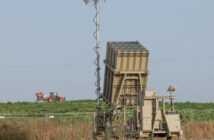Peter Felstead, editor, Jane’s Defence Weekly by IHS Markit
 While 2017 may draw to a close with the Islamic State all but successfully defeated in Iraq and Syria — restoring some semblance of order to the early 21st century geopolitical paradigm — when the year is reviewed through a more traditional ‘Cold War lens’ the outlook does not look so good for the West.
While 2017 may draw to a close with the Islamic State all but successfully defeated in Iraq and Syria — restoring some semblance of order to the early 21st century geopolitical paradigm — when the year is reviewed through a more traditional ‘Cold War lens’ the outlook does not look so good for the West.
Most obviously, not only is the US, as the sole democratically elected superpower, losing its qualitative edge as China’s military-technical development continues apace, but erstwhile main Western adversary Russia has been enjoying success on battlefields both real and virtual over the last few years. This has even included the US political battlefield, given the conclusion from US intelligence services that Russian cyber-influence operations intervened to the advantage of Donald Trump in last year’s US presidential election.
As if that military-geopolitical climate did not look bad enough, added to it now is the fact that volatile international pariah state North Korea can realistically claim it can target all of the US — and by extension possibly Western Europe as well — with intercontinental ballistic missiles following its 29 November Hwaseong-15 test.
China emerges as military superpower
Although the increasing technological capabilities developing within China’s People’s Liberation Army (PLA) were inevitable, the pace at which they have materialised seems to have taken the US military by surprise. For example, in that most obvious manifestation of superpower status — the projection of air power from the sea — China has this year not only continued to work up the combat capabilities of its first aircraft carrier, the Ukrainian-built Liaoning, but on 26 April launched its first domestically produced carrier, known as the Type 001A: the largest ever warship built in a Chinese shipyard.
In November, Rear Admiral Yin Zhuo, director of the PLA Navy’s expert consultation committee, claimed that “thousands of take-offs” have been conducted by J-15 carrier-borne fighters using an electromagnetic launch system expected to be accommodated within the country’s second indigenously built carrier, commonly referred to as the Type 002 — placing the PLA Navy on a technological par with the US Navy and its new Ford carrier class.
More generally, Pentagon officials have identified that China is now pursuing a range of advanced weapons with disruptive military potential, including manoeuvrable re-entry vehicles, hypersonic weapons, directed-energy weapons, electromagnetic railguns, counter-space weapons, and unmanned and artificial intelligence-equipped weapons.
With such an unprecedented break-out occurring in Chinese military technical capabilities, the US military is now firmly regarding China as a near-peer competitor in terms of the military might it can bring to bear.
Russia plays winning hand in geopolitics
Turning to Russia, President Vladimir Putin has this year once again proved himself to be a consummate geopolitical poker player. With a less-than-ideal hand and limited chips on the table, Putin has caused mayhem within the US political system, destabilised eastern Ukraine to just the degree required to maintain a decent buffer with the West, and engineered an outcome positive to Moscow’s interests from the bloody chaos of the conflict in Syria.
Where several years ago the Arab Spring seemed set to sweep away Russia’s clientele in the Middle East and North Africa, Moscow is now emerging as a key influential powerbroker in the Eastern Mediterranean, with a cohort of allies that now even includes Iran and NATO member Turkey.
Putin’s major global priorities for 2018 thus appear on track for success, from power-broking in the Middle East to the FIFA World Cup in June and July, Russia looks set to remain on the front bench of the international order.





